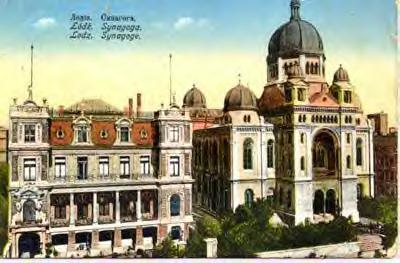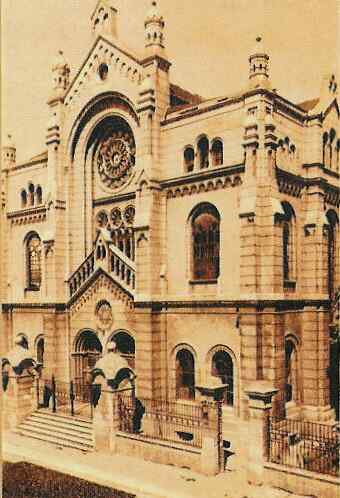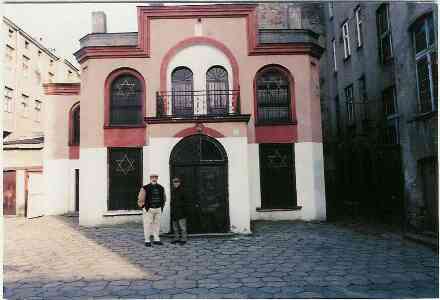Synagogues of Lodz
Main Synagogues
Smaller Synagogues and
Prayer Houses
|
The oldest synagogue in
Lodz was the Orthodox "Altshtot" (Old Town) or
"Stara" synagogue on ul. Wolborska 8. It was constructed
entirely from wood. In 1860 to 1863, the synagogue was relocated to ul.
Wolborska 20 (see map)
and replaced with a new stone building designed by architect Jan
Karol Mertsching (click
here for photos and plan). Major renovation took place from 1897 to
1900, according to a design by well-known Lodz architect Adolf Zeligson. |
|

Postcard of the
"Stary Rynek" (Old Market Square) in
Lodz, ca. 1916, with the synagogue on ul. Wolborska visible in the background
|
Jacob
Warszawski was one of the founders of the synagogue. Benjamin Wiazowski (Wionzowski) was president of the
synagogue. [contributed by Dr.
Charles Silow, great-grandson]
"The synagogue was
very tall and beautiful. It contained two women's galleries. In all,
it held fifteen hundred seats. There were thirty-six Torah scrolls in
the synagogue and a large amount of silver Torah ornaments, including
many antique works of art. All official public ceremonies took place
in this synagogue...
|
"The whole synagogue, with all its interior fixtures and
Torah scrolls, was completely devoured by fire. All that remained was the
western wall, which was shot to pieces by gunfire in April, 1940."
--from The Destruction of the Synagogues
in Lodz, by Rabbi Shimon Huberband, 1909-1942.
The synagogue was burned
on the night of November 15-16, 1939 during the Nazi occupation. No trace of the synagogue remains
today. At present,
the site consists of blocks of apartments. |
| The Reform
synagogue on ul. Spacerowa (now Al.
Kosciuszko 2, see map), known as the "Great" synagogue or "German
Temple," dated from 1883 to 1887 and was
the biggest structure in the heart of the city. Designed by
either Adolf Wolff of
Stuttgart or Hilary Majewski, it was an exact
replica of the Königsberg Temple. The synagogue construction committee
was formed in 1882 by wealthy Lodz industrialist Izrael Kalmanowicz Poznanski,
who also oversaw its construction, which cost over half a million
rubles. The brother of industrialist Dawid
Prussak (1845-1909) was a founder of the synagogue.
|

Postcard photo of the
"Great" Synagogue (right) on ul. Spacerowa
|
The synagogue was completely burned to
the ground on the night of November 14-15, 1939, along with its Torah
scrolls and interior fixtures. Today, the site is used as a parking lot:
photo
#1, photo
#2.
See more pre-war photos: German
Jewish soldiers gathered for prayers near the "Great" Synagogue in 1916 (during
WWI), view
2 and close-up
of view 2
|
The synagogue on ul. Zachodnia 56 (now ul. Zachodnia 70), was known as the Vilker shul.
"The Vilker shul was attached to a beys
midrash (house of study) which contained an extraordinary treasury
of Hebrew books. It was the largest place of Torah study in the city.
There was a time when study in the beys midrash proceeded
uninterrupted for twenty-four hours a day. For this purpose, there
were special mishmorim (study groups) which altered
periodically, to ensure that the place would not be without Torah
study for a single second."
In early November, 1939 the Germans
ordered representatives of the kehillah to arrange services with
a cantor, choir, Torah-reader, and shofar, and call upon the
Jewish population to attend the service.
"The event took
place on Tuesday. The shul was packed with congregants wearing taleysim
and tefillin. Cantor Winograd and his choir conducted the
service. A large number of high-ranking German officers came and filmed
the entire course of the service, immortalizing it on film. Cantor
Winograd sang with the choir a number of selections from the Rosh
Hashanah and Yom Kippur prayers. After that, the order was given to take
out the Torah scroll and read from it...The Torah-reader, a clever Jew,
called out in Hebrew before beginning to read the scroll: 'Today is
Tuesday.' This was meant as a statement for posterity that they were
forced to read the Torah, since the Torah is usually not read on
Tuesdays...
"In the second half of 1940, the
Germans set fire to the interior fixtures of the Vilker shul,
then dismantled the shul. The extraordinary treasury of Hebrew
books, including literally thousands of rarities, was burned, and the
Torah scrolls were sent off to an unknown destination."
--from The Destruction of the Synagogues
in Lodz, by Rabbi Shimon Huberband, 1909-1942.
No trace of the synagogue remains today.
|
|

Postcard photo of the synagogue on ul. Wolczanska |
The synagogue on ul. Wolczanska was also
known as the "Ezras Izrael" Association (Jewish Aid) synagogue
or "Wolynska." The property for the synagogue was purchased in
1899 by a group of Jewish merchants from Lithuania and Belarus (Litvaks).
The synagogue building was constructed in 1899-1904 according to a
design by Gustaw Lande-Gutenteger. Aleksander Poznanski,
Abraham Prussak and the
BELIN family were among the founders and Jozef Abram
Dobrzynski (died 1902) was president
of the Vilker shul.
In 1933, the board of the synagogue consisted of:
Izrael Rubinsztajn, Ber Etkind, Jozef Mikulicki, Uszer Strokowski, Zelig
Nesis, Eliasz Piechowicz, Izrael Menachem Bornsztajn, Izaak Borensztajn
and Lejb Basz. The synagogue was burned down on the night of November
10-11, 1939, and was combined with ill treatment of the Jewish clergy,
as described in Itzchak Katzenelson's epic poem, "Song of the
Murdered Jewish People" (see excerpt below). Rabbi Segal was ordered to tear up the
Torah scrolls with his own hands. The remaining walls of the synagogue
were demolished in March 1940. |
- "...The bullet hits the shammes in the leg
'And now - away from here Jew!'
- The shammes is leading the rabbi, he limps, but
tries to walk faster...
- Yet the rabbi can only run around the bimah - and
can barely walk.
- The shammes leads him to the cracks of the riding
whip...The measure hasn't filled up yet!
- It hasn't been filled until they both have gone -
look, in broad daylight
- Smoke goes straight up into the sky, the fire
flashed with flame in the covers of smoke!
- The synagogue is burning! The house of God is on
fire! Aron ha-kodesh! The Pentateuch rolls are burning!
- The rabbi looks, the shammes holds him: Oh the
measure...the measure is already filled."
-- from "Song of the Murdered Jewish
People," by Itzchak Katzenelson
|
Synagogue on ul. Gdanska 18
The small synagogue at ul. Gdanska 18 (formerly ul. Dluga),
known as the "Ohel Jakov" synagogue, was built in 1898, on a property
already containing a large brick outbuilding and a front tenement house. Gustaw
Landau-Gutenteger was the architect. Registered members of the synagogue
consisted of approximately 100 smaller scale merchants and manufacturers,
residents of the wealthier neighborhood. During World War I, the synagogue came
under the influence of the Zionists and was considered to be an institution of
the Lodz Organization of Zionists. Its members supported the Jewish National
Fund and other Zionist institutions, such as the Jabne school, the Herclija
nursery school, and the Helenowek orphanage (run by Mordechai Chaim Rumkowski).
It was probably burned down by the Germans in 1939 and later demolished in
1940.
| The single
surviving synagogue of Lodz is located at 28 ul. Revolucji 1905
(formerly ul. Poludniowa 28), in the second internal courtyard. The
synagogue was probably designed by Gustaw Lande-Gutenteger and dates
from between 1895 and 1900. Despite the Nazis'
|
 |
destruction of the main synagogues of Lodz in
November 1939, this smaller synagogue probably survived because it was hidden in a corner of the ghetto and used
as a storehouse for salt.
The synagogue was damaged by a fire in 1987. It
was rebuilt
with financial assistance from the
Ronald
S. Lauder Foundation in 1989, and in October of that year was formally
reopened for the Jewish community's use.
|
The single surviving synagogue of Lodz
Photo courtesy of Howard L. Rosen z"l,
1998
|
|

|
The former beit midrash (house of study) on ul. Piotrkowska 114/116 dates
from 1899 and is currently undergoing restoration. It was originally used as a kosher poultry
slaughterhouse.
Photo, 1998 |
Sources include:
- Adelson, Alan and Robert Lapides, eds. Lodz Ghetto:
Inside a Community under Siege. New York: Viking, 1989.
- Walecki, Jacek. Synagogues and Prayer Houses of Lodz (to
1939). Lodz: Ibidem, 2000.
|
|
|